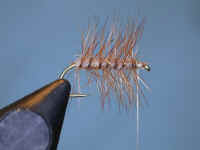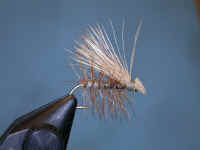|
Fly of
the Month
Bob Ireton brings together his
experience in fly fishing, aquatic entomology, and knowledge of fly
tying techniques and materials, to design and tie durable and
effective flies.
|

|

Volume 4, Issue 5
May 2003

ELK HAIR CADDIS
Fly, Text, and Photography by Bob Ireton
Caddis at rest hold their wings in a tent shape over bodies that are
bulbous and lack tails. The first thoracic segment behind the head is
narrow, creating a waist like effect between the head and the wings. Like
larvae and pupae, the adults have no tails. They do, however, have long
antennae. Their legs are generally long, somewhat strong, and often
outsize. In quite a few cases, the legs are almost a dominant aspect of
the insect.
Fly patterns reflect this shape in various ways. The famous Elk Hair
Caddis style, originated by Dillon, Montana, tier Al Troth, uses palmered
hackle to represent the legs, and elk or deer hair flared at the back and
cut tight at the head to represent both the tent-shaped wing, and the head
beyond its narrow neck. Because of the hackle and hair, the Elk Hair
Caddis is one of the few dressing types that are imitative and also float
very well. When the often sporadic availability of caddis adults is
factored in, it's no accident that Troth's is one of the best
searching-fly styles ever invented.
MATERIALS
Hook - TMC 100, Dai-Riki 300, Daiichi 1100, Mustad 94840, Orvis
1509, or equivalent
standard dry fly hook.
Size - 10-20.
Thread - Tan, 6/0 or 8/0.
Rib - Fine gold wire or tensile.
Body - Tan dry fly dubbing.
Hackle - Ginger dry fly hackle.
Wing - Light yearling Elk body hai
TYING STEPS
| 1 - Secure the hook properly in the vice, and pinch down
barb, if desired. Lay on a thread base from behind the eye rearward,
stopping at a point above the hook barb. Tie a half hitch. |
 |
|
2 - Tie in a piece of the ribbing material above the hook barb,
with the working end extending behind the hook bend. Tie a half hitch.
Now select and prepare a nice dry fly hackle, and tie it in the same
as the ribbing. Tie another half hitch. |
 |
|
3 - With the working thread positioned over the hook barb, apply
the dubbing to the thread in anticipation of forming the body.
|
 |
| 4 - Palmer the thread that has the dubbing forward,
forming a nice body. Remember, you can add more dubbing to the thread
much easier than you can remove it! Stop about two hook eye spaces
behind the hook eye, and tie a half hitch. |
 |
|
5 - Palmer the hackle forward, stopping at the end of the dubbing.
Secure the hackle with several turns of thread, and trim the tag end
of the hackle. Tie a half hitch. |
 |
| 6 - Now carefully counter-wind the ribbing through the
hackle, being careful to avoid mashing down the barbs of the hackle.
Doing this will protect the fragile hackle feather from the teeth of
the fish! Secure the ribbing, and cut off the tag end. Tie a half
hitch. |
 |
|
7 - Select a bunch of yearling Elk hair. For rougher water, use
more hair, and for smooth water, use less. Cut the hair from the hide,
and remove the underfur with a small comb, or your bodkin point. Put
the hair into a stacker with the tips down, and align the tips of the
hair by giving the stacker a few sharp raps on a hard surface.
Carefully remove the hair from the stacker, and align the hair on top
of the hook with the tips facing rearward, and the wing length at
least the length of the entire hook, or slightly longer. Carefully
attach the hair to the hook with a couple of soft loops. Pinch the
hair flat, and tighten the soft loops. If all is looking well,
continue to secure the hair with several harder loops. The trick here
is to tie the thread as tightly as you can, without breaking it! If
the thread does break, continue holding the hair in place, and
reattach the thread. If all else fails, just remove the thread and
hair till you arrive at that nice half hitch from the previous step.
After successfully attaching the wing, tie a couple of half hitches.
You can trim some of the tag end of the hair to make this part easier.
Be careful not to trim too much, though.
|
 |
8 - Now carefully form the head by cutting the Elk hair
at an angle. Tie a couple more half hitches, and a nice whip finish.
Apply some head cement to the thread wraps.
|
 |
The Buckeye United Fly
Fishers, Inc is a non-profit corporation organized under section 501(c)(3)
of the Internal Revenue Code, incorporated in the State of Ohio for the
preservation, conservation and wise use of our fishing waters and game
fish; and to assist in the protection and improvement of our natural
resources
|

![]()
![]()







